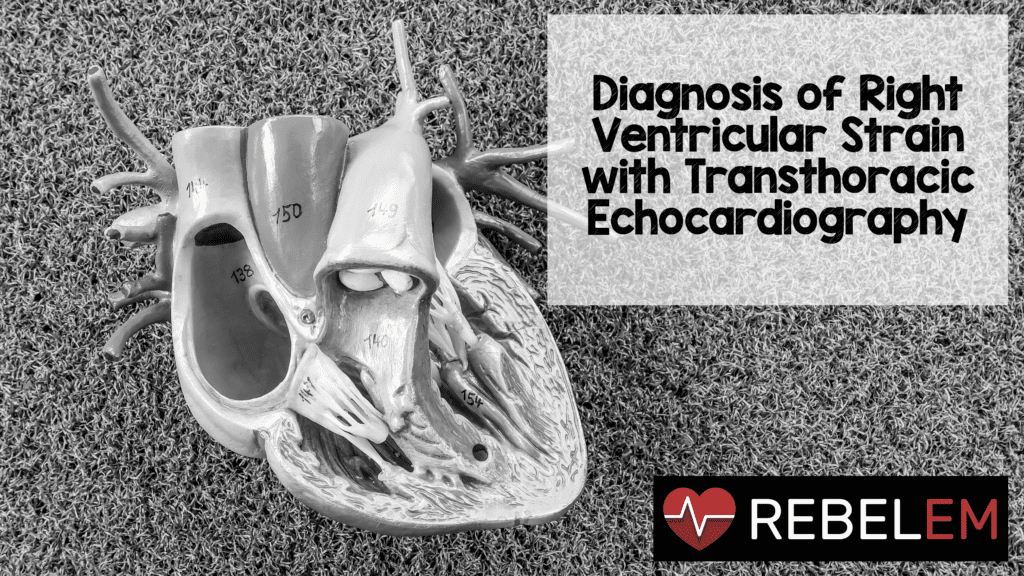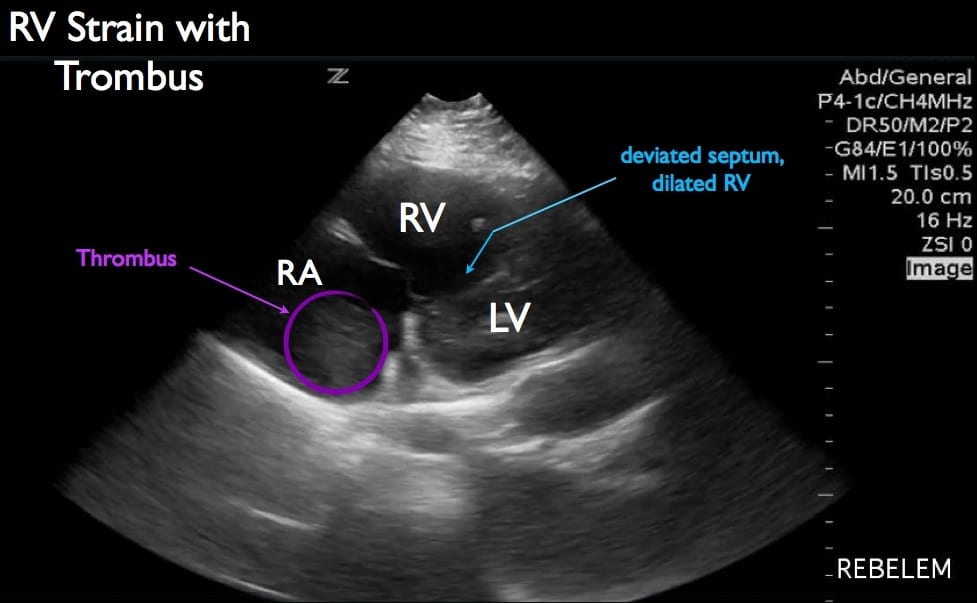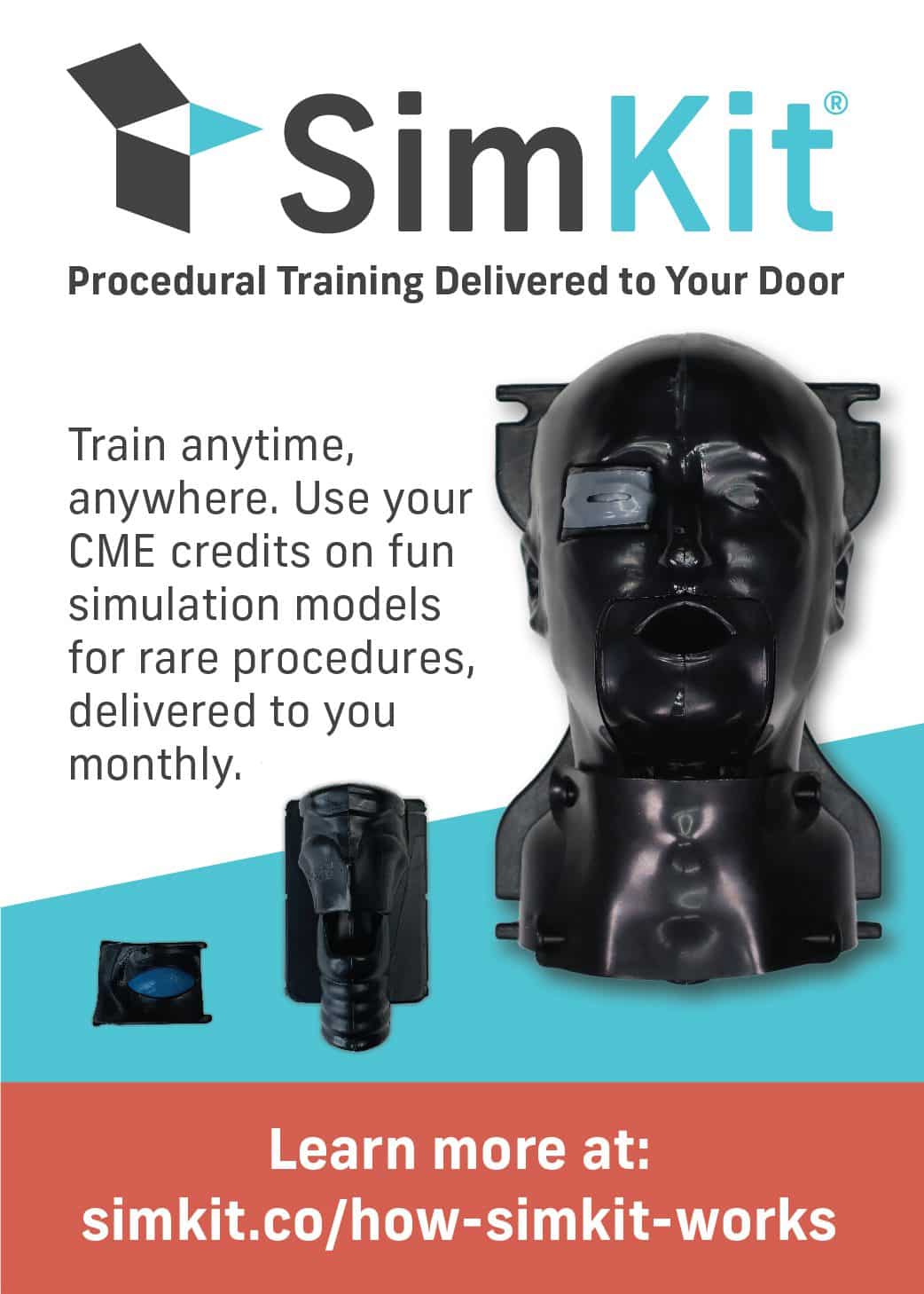 Abnormal vital signs are poor predictors of mortality associated with pulmonary embolism (PE). Diagnosis of PE and right ventricular (RV) strain with transthoracic echocardiography (TTE) however, has been well documented as a predictor for pending shock and significant in-hospital mortality. One study done by Grifoni S et al, showed that 10% of normotensive patients with PE and RV strain on echo developed PE related shock, and 3% died, whereas normotensive patients without signs of RV strain remained hemodynamically stable.
Abnormal vital signs are poor predictors of mortality associated with pulmonary embolism (PE). Diagnosis of PE and right ventricular (RV) strain with transthoracic echocardiography (TTE) however, has been well documented as a predictor for pending shock and significant in-hospital mortality. One study done by Grifoni S et al, showed that 10% of normotensive patients with PE and RV strain on echo developed PE related shock, and 3% died, whereas normotensive patients without signs of RV strain remained hemodynamically stable.
What are the echocardiographic signs of RV dysfunction secondary to PE? [1]
- RV dilatation > 1:1 (normal ratio right: left ventricle is < 0.6:1)
- Right ventricular systolic dysfunction
- McConnell’s sign – mid RV wall hypokinesis with apical sparing
- Moderate to severe tricuspid regurgitation
- Paradoxical septal wall motion towards the left ventricle
- Pulmonary artery dilatation
- Atrial dilatation
- Right heart thrombus or thrombus in transition
- Lack of respiratory variation of the inferior vena cava
Right ventricular dilatation > 1:1 (normal ratio right to left ventricle <0.6:1)
How good is the diagnosis of RV strain with TTE for the diagnosis of PE?

What is the most recent literature analyzing the diagnostic accuracy of TTE for PE? [2]
What they did:
- Prospective evaluation of 146 patients with point-of-care (POC) echocardiography performed by ED physicians for the prediction of PE in moderate to high probability patients
- Positive study = RV dilation > 1:1 ratio
Results:
- 17 patients with RV:LV > 1:1 and 15 found to have PE (2 false positives had COPD)
- 129 patients with no RV Dilatation found to have PE, 114 with no PE
- Sensitivity 50%, Specificity 98%, PPV 88%, NPV 88%
- Positive LR 29 and Negative LR 0.51
- All Patients with a McConnell’s sign were positive for PE
Limitations:
- Not powered sufficiently to determine if additional signs of RV strain or hypokinesis (i.e. TR, McConnell’s Sign, and/or paradoxical septal deviation) improved sensitivity or specificity for the diagnosis of PE
Conclusion:
- RV dilatation and dysfunction on emergency POC echocardiography are very specific, but not very sensitive for PE
McConnell’s sign – mid right ventricular wall hypokinesis with apical sparing
How does RV strain on TTE perform at predicting outcomes in PE patients? [3]
What they did:
- Retrospective review of 161 patients with a diagnosis of PE (CT angiography, VQ scan or final ED diagnosis of PE) and emergency physician performed Focused Cardiac Ultrasound (FOCUS).
Results:
- 161 patients (16%) had adverse outcomes, and 24% of patients had RV strain on FOCUS
- RV strain on FOCUS for prediction of adverse outcomes : Sensitivity = 64%, Specificity = 84%, OR = 9.2
Limitations:
- The retrospective inclusion of only patients who received a FOCUS in the ED creates a selection bias to a sicker group of patients
- Occurrence of adverse outcomes was limited to the duration of hospital stay (which was an average of only 5 days), and may not be adequate
- Diagnosis of RV strain on FOCUS is operator dependent. These results may not be translatable to other physicians without adequate training.
Conclusion:
- FOCUS detection of RV strain is a useful prognostic indicator for in-hospital adverse outcomes
What is a Thrombus in Transit on Echo? How does is affect the prognosis of PE? [4]
A thrombus in transit is described as a worm like thrombus floating between the right atrium (RA) and RV. It’s highly mobile differentiating it from a mural thrombus, which forms in situ.
How does thrombus in transit on echo affect Prognosis in PE? [5]
- A meta-analysis of 1113 patients from the International Cooperative Pulmonary Embolism Registry, all had a baseline echocardiography.
- 42 patients that had a right heart thrombus on baseline echo.>
- Mortality was twice as high for patients with right heart thrombus and PE compared to those without right heart thrombus

Conclusion:
- Thrombus in transit on echo has a higher mortality than no right heart thrombus.
- The difference in mortality was more pronounced in the heparin alone treatment group (vs. lytics or embolectomy)

In a retrospective study by Rose et al (2002) [6] patients with PE and a right heart thrombus had a mortality of 27%. They found these patients did better when treated more aggressively (i.e. thrombolysis or embolectomy)

TAKE HOME POINTS
- Point of Care echo is very good for the detection of RV strain
- In the setting of suspected PE, RV strain on echo is not sensitive for the prediction of PE but it is more specific.
- In the setting of hemodynamic instability the detection of RV strain seems to be very specific for PE
- The finding of a right heart thrombus in the setting of PE and RV strain doubles the mortality up to 29%
- Echo identified right heart thrombus most likely requires more aggressive treatment such as embolectomy or lytic therapy compared to heparin alone, however this requires further investigation
References:
- Rudoni RR et al. Use of Two-Dimensional Echocardiography for the Diagnosis of Pulmonary Embolus. J Emerg Med 1998. PMID: 9472752
- Dresden S et al. Right Ventricular Dilatation on Bedside Echocardiography Performed by Emergency Physicians Aids in the Diagnosis of Pulmonary Embolism. Ann Emerg Med 2014. PMID: 24075286
- Taylor RA et al. Point-of-Care Focused Cardiac Ultrasound for Prediction of Pulmonary Embolism Adverse Outcomes. J Emerg Med 2013. PMID: 23827166
- Byrne MW. Image in Emergency Medicine. Elderly Female with Syncope. Venous Thromboembolism “in transit.” Ann Emerg Med 2011. PMID: 21689570
- Torbicki A et al. Right Heart thrombi in Pulmonary embolism: Results from the International Cooperative Pulmonary Embolism Registry. JACC 2003. PMID: 12821255
- Rose PS et al. Treatment of Right Heart thromboembolism. CHEST 2002. PMID: 11888964
- Nazeyrollas P et al. Use of Transthoracic Doppler Echocardiography Combined with clinical and Electrocardiographic Data to Predict Acute Pulmonary Embolism. Our Heart J 1996. PMID: 8737110
- Perrier A et al. Diagnostic Accuracy of Doppler-Echocardiography in Unselected Patients with Suspected Pulmonary Embolism. Int J Cardiol 1998. PMID: 9699938
- Grifoni S et al. Utility of an Integrated Clinical, Echocardiographic, and Venous Ultrasonographic Approach for Triage of Patients with Suspected Pulmonary Embolism. Am J Cardiol 1998. PMID: 9832100
- Miniati M et al. value of Transthoracic Echocardiography in the Diagnosis of Pulmonary Embolism: Results of a prospective Study in Unselected Patients. Am J Med 2001. PMID: 11343666



